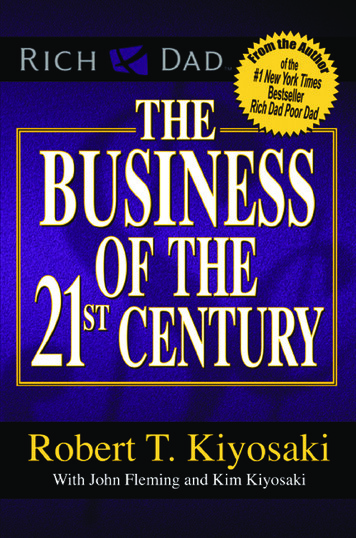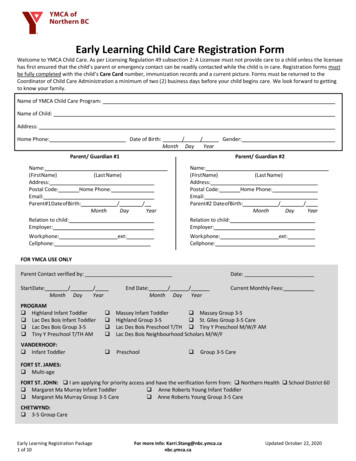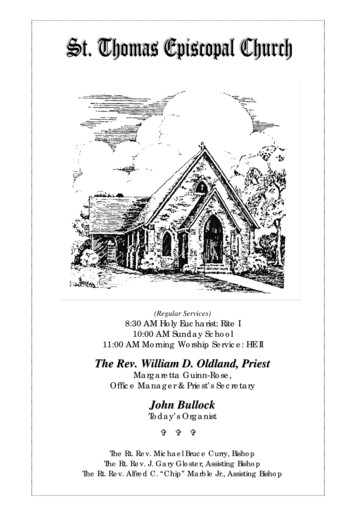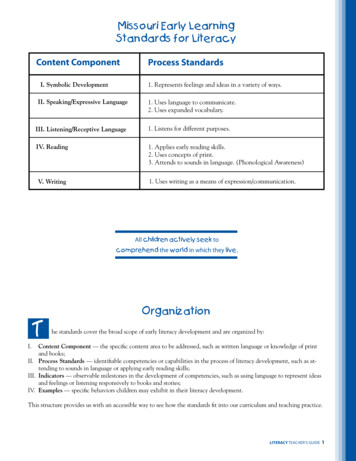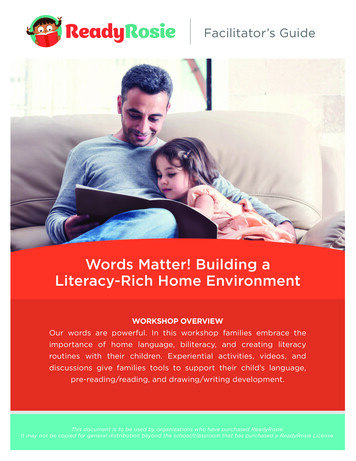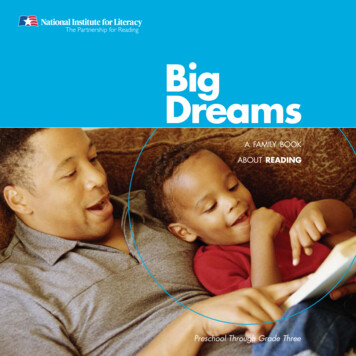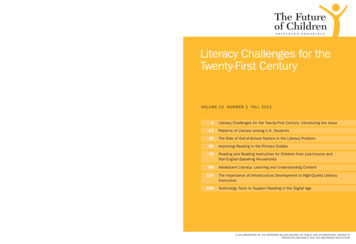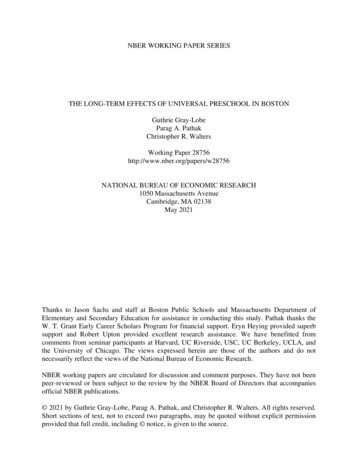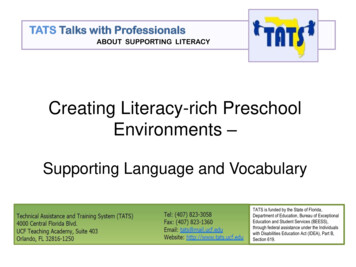
Transcription
TATS Talks with ProfessionalsABOUT SUPPORTING LITERACYCreating Literacy-rich PreschoolEnvironments –Supporting Language and VocabularyTATS is funded by the State of Florida,Department of Education, Bureau of ExceptionalEducation and Student Services (BEESS),through federal assistance under the Individualswith Disabilities Education Act (IDEA), Part B,Section 619.
Literacy-rich and print-rich are oftenused interchangeably. They refer toan environment that supports allfour domains of language: reading,writing, speaking and listening.Literacy and print rich classroomsprovide support with a variety ofprinted and literacy-relatedmaterials. These materials areincorporated throughout the dailyroutines, activities, and centers.Most importantly, the environmentsupports literacy, vocabulary, andlanguage throughout the day andacross activities; not in isolation butintegrated into at every opportunity.
Literacy/Library CenterSharing books withchildren not onlymotivates them to learnto read but alsopromotes learning inother areas.How to Create the Center:o Include books related to topics you areexploring in your thematic unitso Rotate books so that children build skills anddiscover new interestso Keep a few class favorite books in the centero Display books on low shelveso Provide stuffed animals, puppetso Create a listening center nearby with recordedbooks and books with songso Organize books into shelves or basketsrelated to topics or themes (label thecategories)Accommodations/Supports:o Include simple picture books that are highinteresto Include class-made books with photos of thechildren and of functional environmental text
Ideas for Accommodations and Supports toMeet the Needs of all ChildrenIncrease physical access to books Choose durable books with clear pictures and simple text. Consider optimal physical positioning for a child’s comfortand stability. Attach “page fluffers” to help separate the pages. Usevelcro or textured fabric to help the child hold the book inplace. Include materials with large print, bright and contrastingcolors. Include recorded stories with sound effects to help teachstory structure.
Literacy/Library Center
Ideas for Accommodations and Supports toMeet the Needs of all ChildrenBoost cognitive access to books Simplify books by shortening sentence text as you read. During shared reading, give students props such as stuffedanimals and photographs that correspond to the story. Use highlighter tape to emphasize important words thatrelate to pictures or plot. Introduce graphic symbols and pictures that help supportthe story. Help children connect their own familiar experiences to thecharacters and plots. Make simple classroom books that catch a child’s interest. Choose or make interactive books
Writing CenterWriting materials encouragechildren’s languagedevelopment andself-expression. Childrencan build the fine motorskills needed for writing (forexample, pencil grip, handeye coordination).How to Create the Center:o Provide a variety of writing tools, paper,and other kinds of writing surfaceso Post a list of children’s names, post photoswith labels, charts of environmental texto Provide book-making materials such ashole puncher, stapler, yarno Provide ready-made blank bookso Provide “mailboxes” for children and adults(label mailboxes with names and photos)Accommodations/Supports:o Provide adapted writing tools along withlarge-area surfaceso Include magazines with photos of interestfor cutting out and gluingo Encourage expression and communicationby allowing children to dictate or “show”what they want to write
Writing Center Activity
Literacy and Writing Centers Activities
Science CenterChildren discuss theirdiscoveries with oneanother and practicelooking up information innonfiction booksand texts.How to Create the Center:o Include materials for small groupactivities so children can expand ontheir interestso Label items such as magnifyingglasses, rulers, balance scales andprovide photos to give ideas for theiruseso Include books, writing materials,photos and pictures related to sciencetopics (dinosaurs, animals, plants,weather)Accommodations/Supports:o Include simple materials such ascause and effect toys and real-lifeobjects. Label these and provideexamples for using them.
Dramatic Play CenterChildren take on roles,express their ideas anddevelop plans for play, talkwith one another and theirteachers, and includereading and writing in theirplay.How to Create the Center:o Include props and play materials relatedto places and events that are familiar andinteresting to childreno Include items for recreating a home,grocery store, office, restaurant, doctor’sor veterinarian’s office, barber/beautyshop. Label these with text and photoso Include paper, pencils, clipboards,magazines, and file folders for children touse in play scenarioso Include items to read such as tickets,price tags, and signsAccommodations/Supports:o Include social books and social scripts toillustrate ways to play in the center anduse of the materialso Label with photos of actual items to helpchildren generalize
Block or Dramatic Play Center
Block CenterChildren create and follow aplan for building anddescribe or label theircreations. They relatebuilding and objects in thecenter to real-life situations.How to Create the Center:o Include books related to building, signs,transportation, farms, airportso Label types of blocks as well as propso Rotate books so that children build skillsand discover new interestso Provide photos of ideas of structures tobuildo Include paper and writing materials sothat children can label their structuresAccommodations/Supports:o Provide props such as types oftransportation for sorting and classifyingactivitieso Include examples and step-by-stepvisuals for building with wooden blocksas well as lego-type blocks
Block Center
Ideas for Accommodations and Supports toMeet the Needs of all ChildrenIncrease participation in play centers Give children an easy-to-follow recipe with pictures andmagnetic-backed food icons to stick on cookie sheets. Include picture icons with printed words along with velcrobacked pictures for making menus, “writing” shopping lists,or pretending to cook in dramatic play. Display dress-up theme pictures labeled with thecorresponding text (princess, doctor, pirate). Help childrenuse these visuals, a word board, or AAC to “tell a story” ofthe character.
References and ResourcesCreating Rich Language and Literacy Environments: A Resource Set. New York StateEducation Department with NY Prekindergarten Foundation for the Common Core andNY Office of Early Learning. acy-Rich Preschool Environments for All Learners. Brookes Publishing Language andLiteracy Development Series. eschoolenvironments-for-all-learners/Pool, Judi and Deborah Carter. Creating Print-Rich Learning Centers. Teaching YoungChildren, vol. 4, no. 4.Snow, C., Burns, S., Griffin, P., Language and Literacy Environments in Preschools. ReadingRockets. -literacy-environmentspreschoolsUDL-Aligned Strategies. https://goalbookapp.com/toolkit/strategies
Literacy-rich and print-rich are often used interchangeably. They refer to an environment that supports all four domains of language: reading, writing, speaking and listening. Literacy and print rich classrooms provide support with a variety of printed and literacy-related materia

